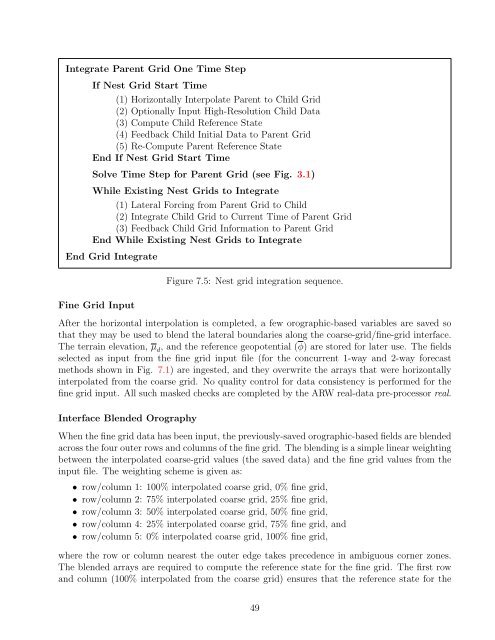Advanced Research WRF (ARW) Technical Note - MMM - University ...
Advanced Research WRF (ARW) Technical Note - MMM - University ...
Advanced Research WRF (ARW) Technical Note - MMM - University ...
You also want an ePaper? Increase the reach of your titles
YUMPU automatically turns print PDFs into web optimized ePapers that Google loves.
Integrate Parent Grid One Time Step<br />
If Nest Grid Start Time<br />
(1) Horizontally Interpolate Parent to Child Grid<br />
(2) Optionally Input High-Resolution Child Data<br />
(3) Compute Child Reference State<br />
(4) Feedback Child Initial Data to Parent Grid<br />
(5) Re-Compute Parent Reference State<br />
End If Nest Grid Start Time<br />
Solve Time Step for Parent Grid (see Fig. 3.1)<br />
While Existing Nest Grids to Integrate<br />
(1) Lateral Forcing from Parent Grid to Child<br />
(2) Integrate Child Grid to Current Time of Parent Grid<br />
(3) Feedback Child Grid Information to Parent Grid<br />
End While Existing Nest Grids to Integrate<br />
End Grid Integrate<br />
Fine Grid Input<br />
Figure 7.5: Nest grid integration sequence.<br />
After the horizontal interpolation is completed, a few orographic-based variables are saved so<br />
that they may be used to blend the lateral boundaries along the coarse-grid/fine-grid interface.<br />
The terrain elevation, µ d, and the reference geopotential (φ) are stored for later use. The fields<br />
selected as input from the fine grid input file (for the concurrent 1-way and 2-way forecast<br />
methods shown in Fig. 7.1) are ingested, and they overwrite the arrays that were horizontally<br />
interpolated from the coarse grid. No quality control for data consistency is performed for the<br />
fine grid input. All such masked checks are completed by the <strong>ARW</strong> real-data pre-processor real.<br />
Interface Blended Orography<br />
When the fine grid data has been input, the previously-saved orographic-based fields are blended<br />
across the four outer rows and columns of the fine grid. The blending is a simple linear weighting<br />
between the interpolated coarse-grid values (the saved data) and the fine grid values from the<br />
input file. The weighting scheme is given as:<br />
• row/column 1: 100% interpolated coarse grid, 0% fine grid,<br />
• row/column 2: 75% interpolated coarse grid, 25% fine grid,<br />
• row/column 3: 50% interpolated coarse grid, 50% fine grid,<br />
• row/column 4: 25% interpolated coarse grid, 75% fine grid, and<br />
• row/column 5: 0% interpolated coarse grid, 100% fine grid,<br />
where the row or column nearest the outer edge takes precedence in ambiguous corner zones.<br />
The blended arrays are required to compute the reference state for the fine grid. The first row<br />
and column (100% interpolated from the coarse grid) ensures that the reference state for the<br />
49
















